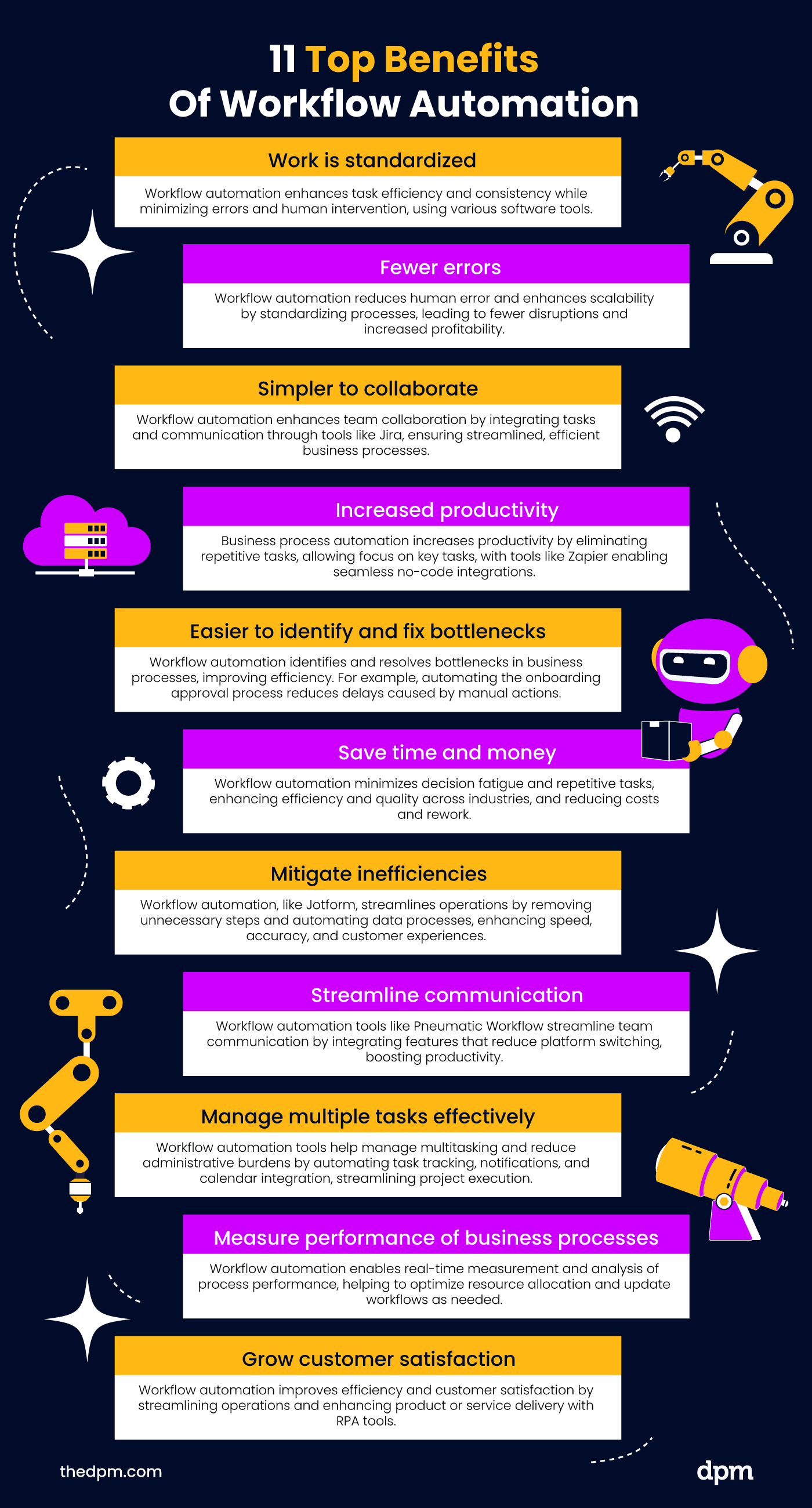Workflow Automation Benefits: Workflow automation standardizes tasks, ensuring consistency, reducing errors, and saving time across your business processes.
Improve Communication: Automation tools simplify collaboration by connecting tasks, software, and people, keeping everyone aligned and informed.
Eliminate Bottlenecks: Automating your processes can also help you spot slowdowns in your workflows and fix them effortlessly, creating a smoother and faster process overall.
Boost Customer Satisfaction: Efficient workflows lead to quicker responses and higher-quality service, directly improving the customer experience.
Save Time: By automating repetitive tasks, your team can shift their energy to high-impact work that drives results and innovation.
Feeling overwhelmed by repetitive tasks, missed deadlines, or team miscommunication? Workflow automation might just be the solution you need. From reducing human error to saving time and money, the benefits of workflow automation can make a real difference. Keep reading to discover how workflow automation can solve common challenges, explore top tools and apps, and get practical tips to implement automation in your workflows.

1. Work Is Standardized
Workflow automation can streamline workflows by standardizing the various processes for certain tasks. It clearly defines the steps of the process for all users, optimizes processes by reducing variability, ensures consistent quality, and allows for the process to be infinitely repeatable.
Workflow automation reduces the amount of human error and enforces a predefined process of best practices for completing tasks. When work is standardized, you can accomplish more in less time with less human intervention, making the overall business process go smoother.
There are a variety of workflow automation software tools and apps that you can use to standardize your business workflows.
2. Fewer Errors
Manual processes are notorious for leading to mistakes—it’s just part of being human. One of the benefits of workflow automation is that it can significantly reduce errors caused by uninformed decisions or simple slip-ups.
Think about data entry: it’s repetitive, tedious, and full of opportunities for things to go wrong. But it’s not just data entry—errors can creep into any part of your operations, and if they’re not caught, they can snowball into major disruptions that impact your bottom line and derail your projects.
That’s why one of the biggest perks of workflow automation is its ability to catch—and eliminate—errors before they become problems.
3. Simpler To Collaborate
Another top benefit of workflow automation is how it streamlines the process of collaborating as a team. Using a process automation tool can connect multiple entities—people, software, and tasks—without having to manually enter every data point.
Process automation software does more than allow communication between employees. It can provide views of things like task completion, CRM updates, human resource operations, and a variety of other useful metrics. This means everyone is working from the same set of information.
Integrating workflow automation solutions allows your entire project management process to operate smoothly while incorporating the most important people with their relevant tasks. This means you can simply collaborate without bogging people down with parts of the process that don't concern them.
Jira Software, as an example, allows you to communicate and collaborate in real-time and is an effective management tool for all of your business processes.
4. Increased Productivity
Workflow automation should make your life and job easier—if it’s not boosting productivity and cutting out repetitive tasks, what’s the point?
Take something like a content approval process. When you and your team aren’t bogged down by manual steps, you can shift your energy to what really matters: doing your best, most impactful work.
There are plenty of low-code to no-code apps, open-source workflow software, and workflow automation tools available to streamline processes and digitize your workflows. When it comes to no-code automation tools, Zapier is the premier tool for robotic process automation (RPA) utilizing integrations with other tools like ChatGPT, Asana, and even Outlook.
5. Easier To Identify And Fix Bottlenecks
Every business process has its slow spots—tasks that take longer than they should or don’t get done as effectively as possible. That’s where workflow automation really shines: it helps you spot those bottlenecks and fix them before they cause bigger problems.
Consider this workflow automation example: You've just hired someone new at your company. Instead of hitting the ground running, their onboarding is stalled while they wait for someone to approve access to key documents or templates. With automation, you can streamline that entire process, turning it into a smooth, hands-off workflow with just a simple drag-and-drop on your automation platform.
6. Save Time And Money
Decision fatigue is no joke, and one of the primary benefits of workflow automation is that it can get rid of a ton of decision-making processes that take up employee time.
When considering the pricing of workflow automation tools and apps, the savings far outweigh the costs of purchasing and utilizing these tools by drastically reducing the amount of rework or double-checking required before completing projects.
This not only saves money—it saves the time of your employees doing this rework and allowing them to focus on more important tasks.
Workflow management is all about finding the right workflow management tools that can help save time and money while improving quality and efficiency.
Whether you are in healthcare or the CEO of Microsoft, there is nothing more important than maximizing the efficiency of your processes. Workflow automation software and tools are the best way to accomplish those goals.
7. Mitigate Inefficiencies
Another important benefit of workflow automation is its ability to address inefficiencies in your business processes. Often, workflow systems include extra steps that might appear useful on paper but end up wasting time, increasing costs, or subtly diminishing the customer experience. Automation helps streamline these processes so that every step adds real value.
Stakeholders might notice the follow up process for onboarding clients, for example, might take several hours or even days when some of the process could be automated entirely.
While a special interaction may be needed at some point, onboarding clients as quickly as possible and giving them as much information as possible may be the difference between a positive customer experience and a negative one.
Jotform is a great example of a workflow app at its best when it comes to mitigating inefficiencies. Jotform specializes in reducing manual tasks by automating the data collection and data entry process from start to finish. This means employees have the information they need, when they need it, without having to double check any of the data.
8. Streamline Communication
While we touched on collaboration earlier, we didn’t talk about communication tools.
Routing teams to multiple different platforms for different tasks can be frustrating and confusing, especially when those platforms don’t have communication tools built in.
While there are some truly great tools out there for communicating as a team, finding a workflow automation system that has some type of built-in communication capabilities is important. This means you can spend less time switching between tools and more time getting your best work completed.
Finding workflow automation software that can keep team members updated with tasks and processes via notifications or built-in chat systems can streamline your team communication without adding any additional friction.
Pneumatic Workflow is a workflow automation software that excels at streamlining communication among your team members.
9. Manage Multiple Tasks Effectively
Managing multiple tasks is one of the most time-consuming parts of project management. The mental toll of switching between tasks can be exhausting and can slow down your entire team when there are so many tasks to be done simultaneously for a smooth execution.
Workflow processes include plenty of important administrative level tasks, but these processes also include minor tasks that all have to be executed in quick succession.
Managing these tasks and employees can be tedious. Having a workflow automation tool or a workflow automation tool that implements AI to manage these tasks, statuses, and employees can nearly eliminate all low-level administrative tasks.
The best workflow automation tools for your team will be able to handle multiple tasks, manage notifications for team members with upcoming or overdue tasks, and integrate with your calendar.
10. Measure Performance Of Business Processes
One of the major benefits of workflow automation is the ability to measure absolutely everything in real-time.
Even if you can’t get everything you want automated, being able to see and monitor the data of how processes are improving can help you make informed decisions on where your team’s time is being eaten away or where resources are being over-allocated on specific tasks.
If you already have established workflows, business process automation software can measure the performance of your workflows and help you determine if they are effective in the first place. What worked once upon a time may no longer be effective in your current landscape.
The only way you can possibly know what to improve is by measuring and analyzing as much data as possible.
Want to dig deeper into how to monitor, evaluate, and improve performance using automation? Business process automation courses can teach you how to interpret workflow data and apply process optimization techniques that drive results.
11. Grow Customer Satisfaction
When your work is consistent, communication flows smoothly, and tasks are handled efficiently, your customers will notice the difference. Workflow automation helps you eliminate delays, deliver better products or services, and create a smoother experience overall.
One of the biggest perks of workflow automation is how it boosts customer satisfaction—and makes it scalable. By improving your team's workflows with tools like RPA (robotic process automation), you can steadily enhance the experience you’re offering.
If tracking customer satisfaction is part of your process, consider tools like Qntrl. Its machine learning features collect feedback and use it to suggest improvements for your workflows, ensuring your customer experience keeps getting better over time.
Keep Learning How To Use Workflow Automation Software
Join our membership community to access 100+ templates, samples, and examples while connecting with 100s of other digital project managers in Slack.




